An Illustrated History of Old Sutton in St Helens, Lancashire
Part 24 (of 95 parts) - Sutton Shops & Businesses
d) Sutton's Post Offices and Postal Service | e) Memories of Old Sutton Shops
Researched & Written by Stephen Wainwright ©MMXX Contact Me Research Sources
c) Shopkeepers & Strikes | d) Sutton's Post Offices
e) Sutton Shop Memories Plus: Industry in Sutton
Researched & Written by Stephen Wainwright ©MMXX
Old Sutton in St Helens
Sutton Shop Adverts
Shopkeepers & Strikes
Sutton's Post Offices
Sutton Shop Memories
Sutton Shops Notes and Photographs
During the 1920s there were four barbers' shops within Sutton. John 'Jack' Heyes had a barber's at 91 Junction Lane and there were two in Peckers Hill Road. Peter Evans had premises where the Lloyds TSB Bank is presently located and another barber's was at the junction of Peckers Hill Road and Powell Street. Lawrence Fowles also had a shop in Waterdale Crescent. The barbers' cut hair for between six pence to a shilling and shaved men’s beards for twopence. There was also one at 5 Clock Face Road according to a 1914 advert. After the war William Squires had a barber's shop in Ellamsbridge Road until a demolition notice was served on him in 1962 and he relocated to Burtonwood.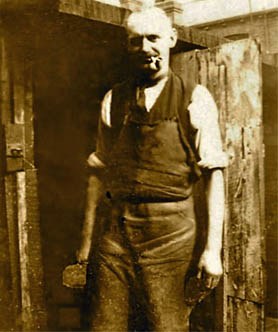
Contributed by Brenda MacDonald
There was also boot and clog maker John Frederick Heyes who made clogs to order for the miners in his backyard at 11 Oxley Street and Peter Spakausk (known as 'Pe Spak') who had sheds at the top of Pendlebury Street in Sutton Manor. In the 1881 census, Nathaniel Harwood and sons James, Ralph and Robert were all listed as cloggers at 27 Peasley Cross Lane, next door to the Alma Vaults. It also listed Thomas Dutton, a clogger at the 'Back of 17' Watery Lane.
At the rear of the Coppersmiths Pub at 296 Watery Lane there used to be a wooden shed that sold sweets and other items. Glover’s Hut was said to be a haven for card players lit by paraffin lamps and in the back room was a place for pop drinkers who also played cards.

Headed notepaper of painter and decorator James Prescott of Robins Lane, Sutton from around 1911

Headed notepaper of painter and decorator James Prescott around 1911

Painter James Prescott invoice c.1911

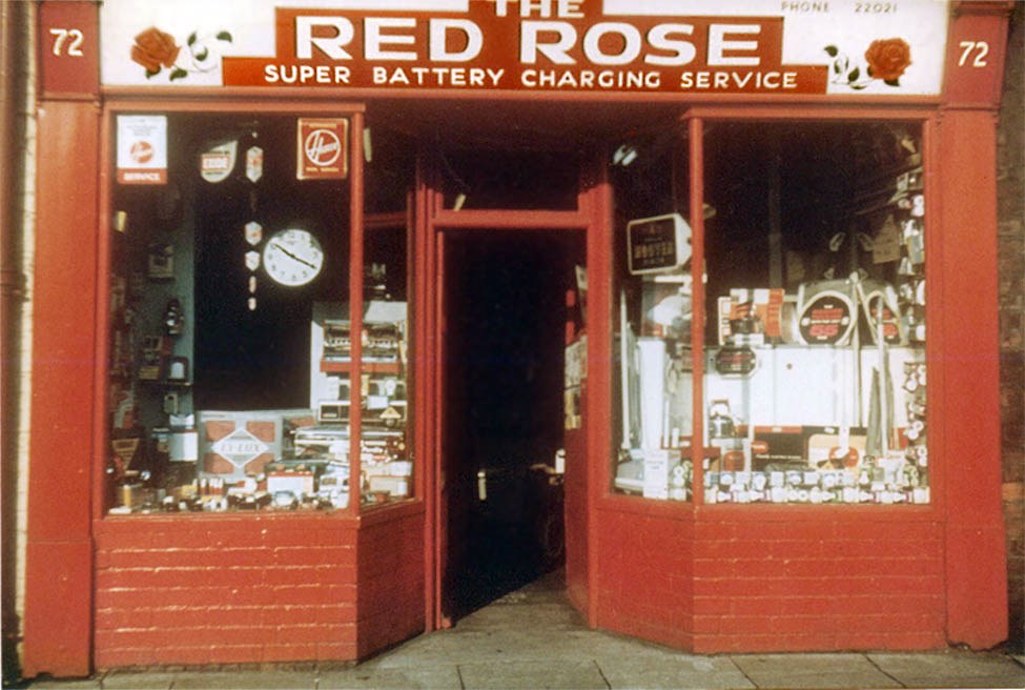
The Red Rose bicycle and electrical shop at 72 Peckershill Road, Sutton - contributed by Tom Williams

Red Rose bicycle and electrical shop at 72 Peckershill Road, Sutton

Red Rose bicycle and electrical shop
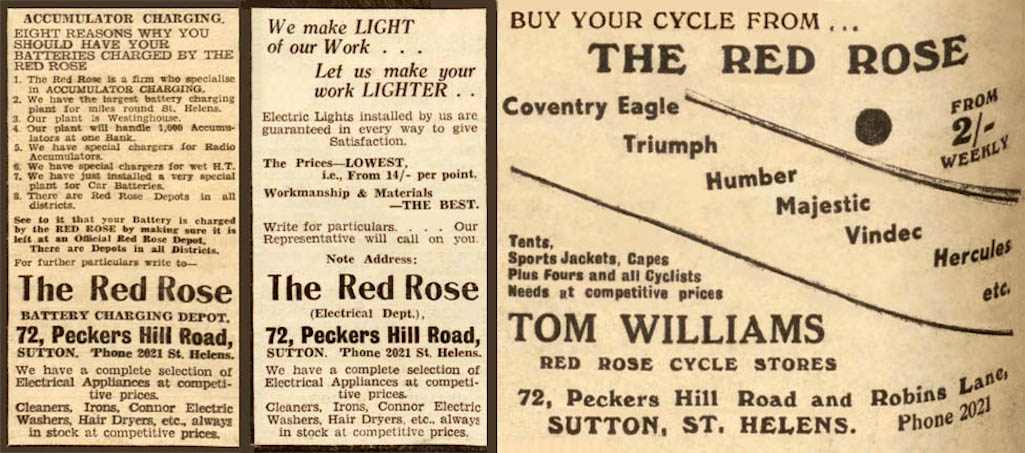
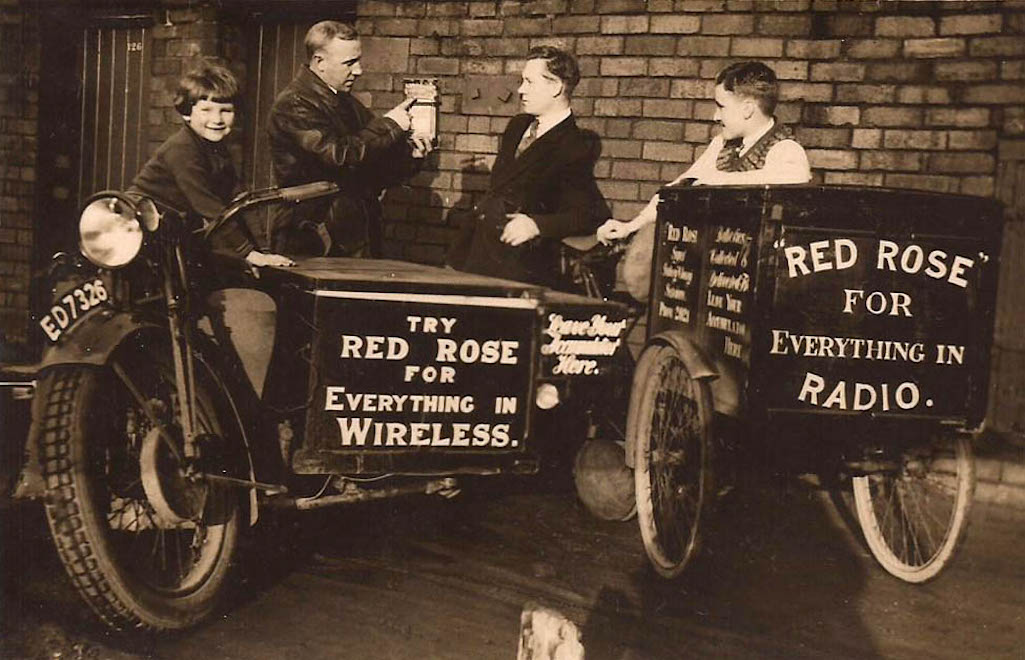
The owner of Red Rose Tom Williams holds a lead acid accumulator - contributed by nephew Tom Williams

The owner of Red Rose Tom Williams holds a lead acid accumulator

The owner of Red Rose Tom Williams holds a lead acid accumulator

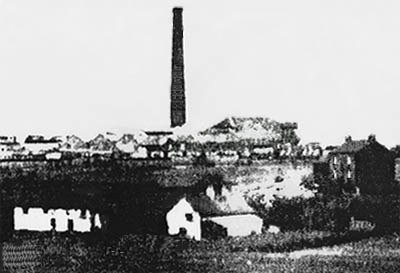
The six rows of terraced houses within Edgeworth Street of the 1920s and '30s contained eight shops. Four of them were just converted front rooms, without any alterations to the original house windows. They were mainly small grocery and sweet shops that also took orders for bread and were run by Agnes Jones at no. 58, Marion McVittie at 74 and Mary Beesley at 88. The exception was Millie (Mildred) Price at no. 51, who had a small pork butcher's that sold cow heels, trotters and savoury duck. Fred (later son Harold) Hill's grocers at 31 Edgeworth Street also offered toffees, such as Kali Suckers, Atty's Mint Balls and lucky bags.
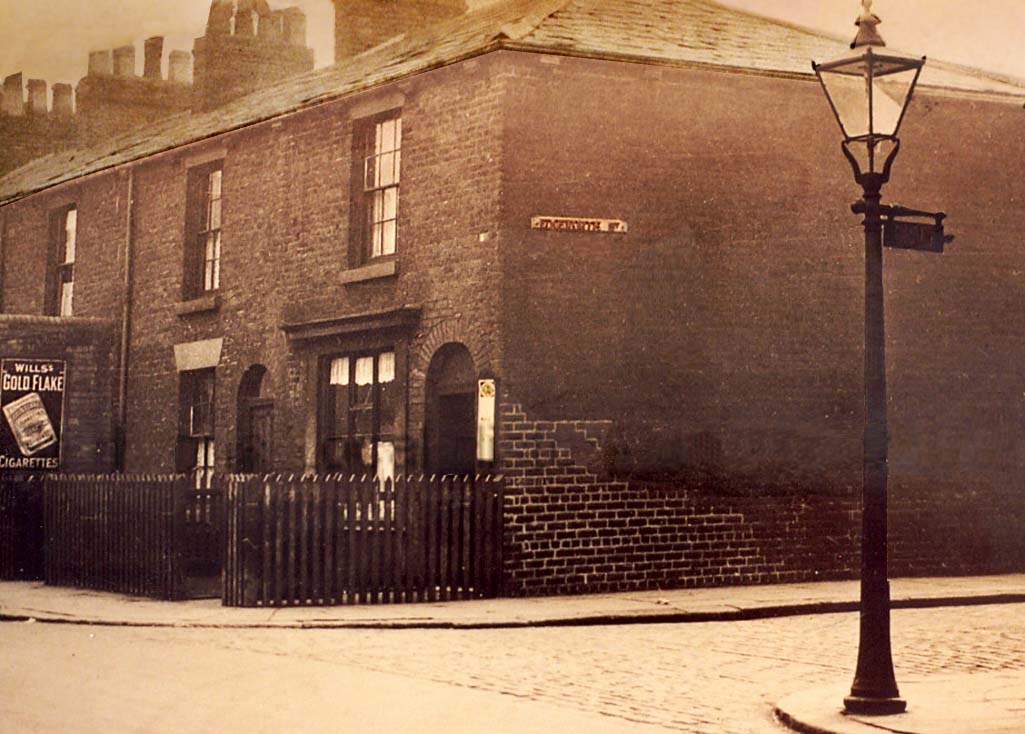
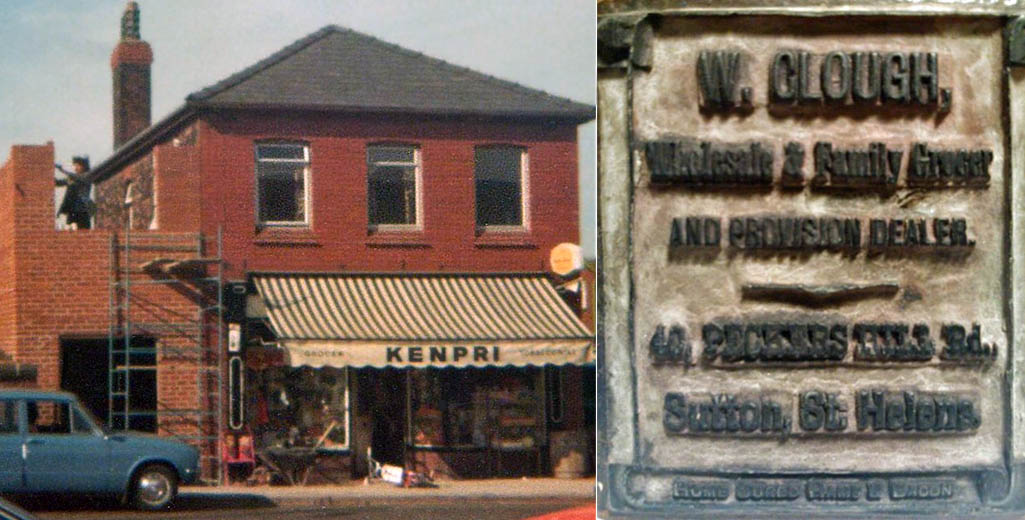
Kenpri of Mill Lane contributed by Ian Rice and sign / plaque of Clough's grocer's of Peckers Hill Road contributed by Ged Clough

Kenpri of Mill Lane and plaque of Clough's grocer's of Peckers Hill Road

Kenpri and sign / plaque of Clough's grocer's
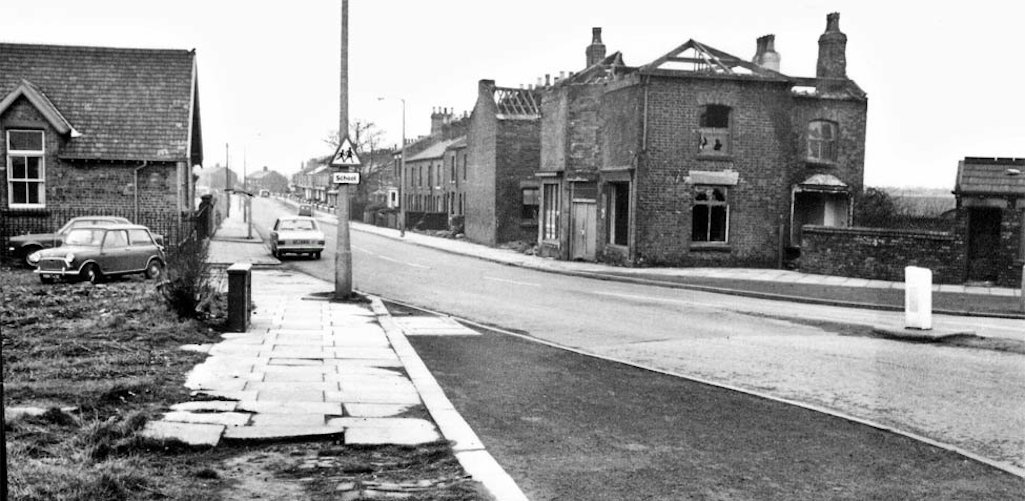
The derelict Lucy Bath's post office and general store photographed by Jim Lamb on March 31st 1970

The derelict Lucy Bath's post office and general store photographed in 1970

The derelict Lucy Bath's in 1970
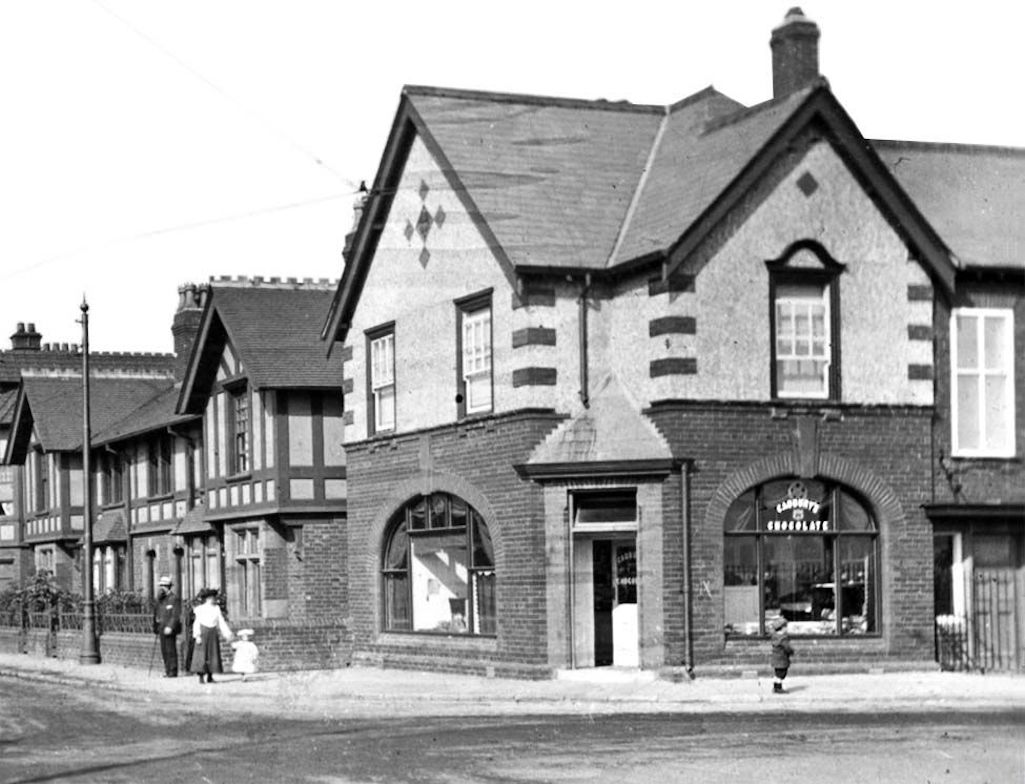
Confectioner's shop on the corner of Robins Lane & Marshalls Cross Road c.1910 - the building still exists, built in 1906

Confectioner's on the corner of Robins Lane & Marshalls Cross Road c.1910

Confectioner's shop at the bottom of Robins Lane in about 1910
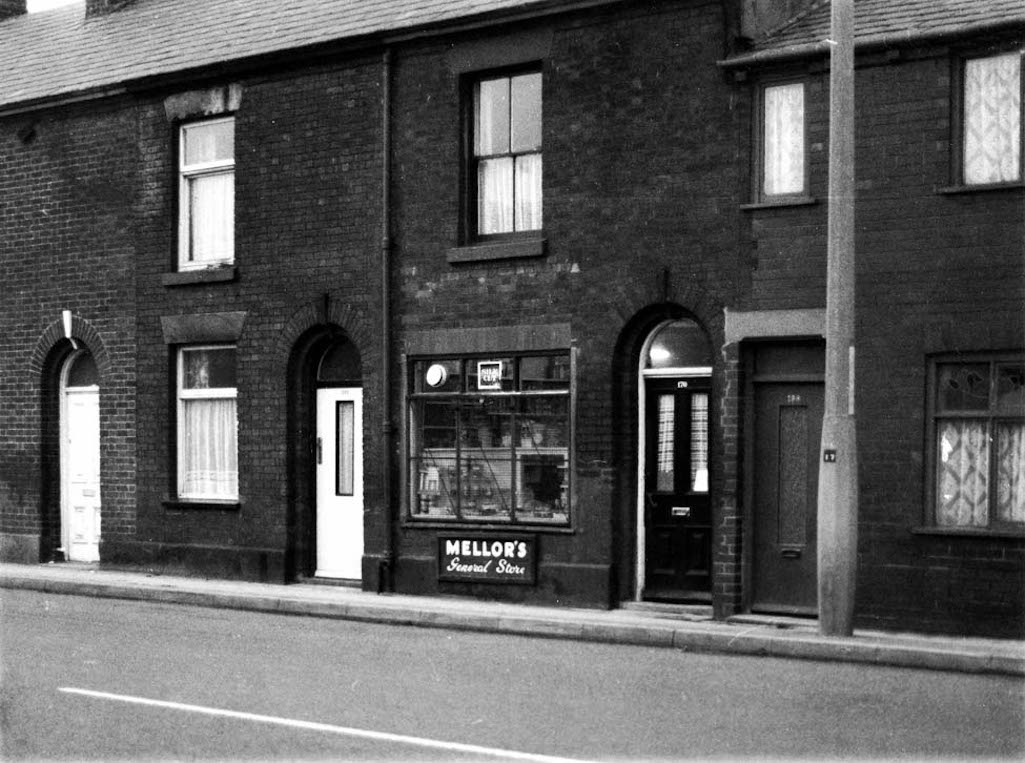
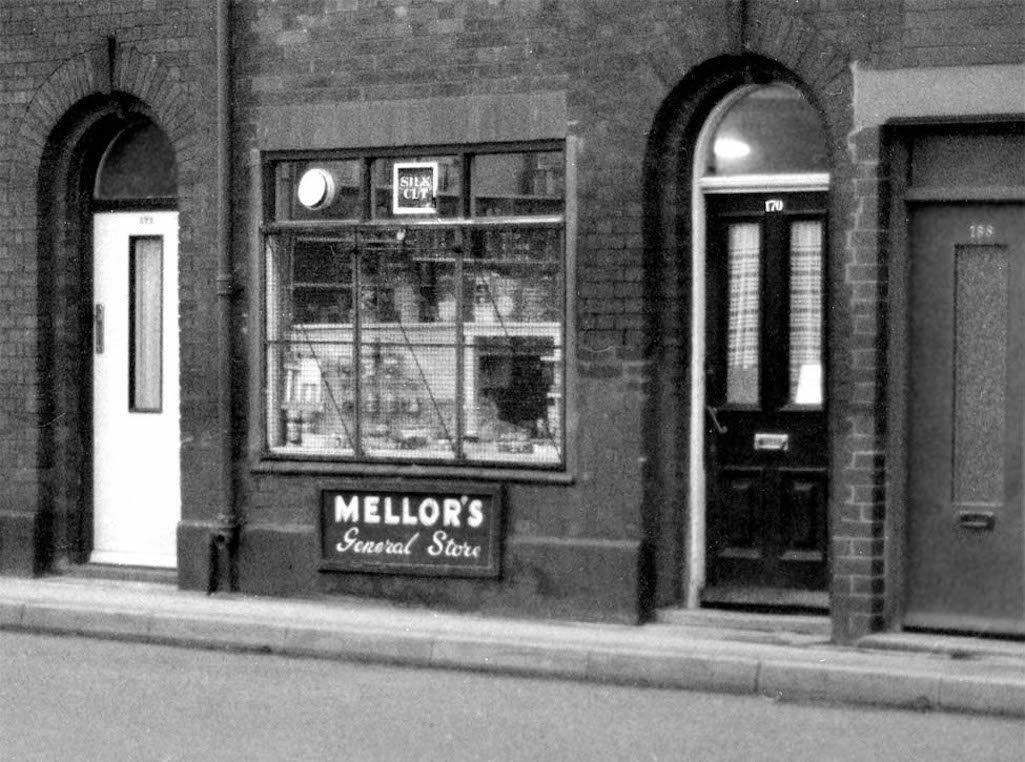
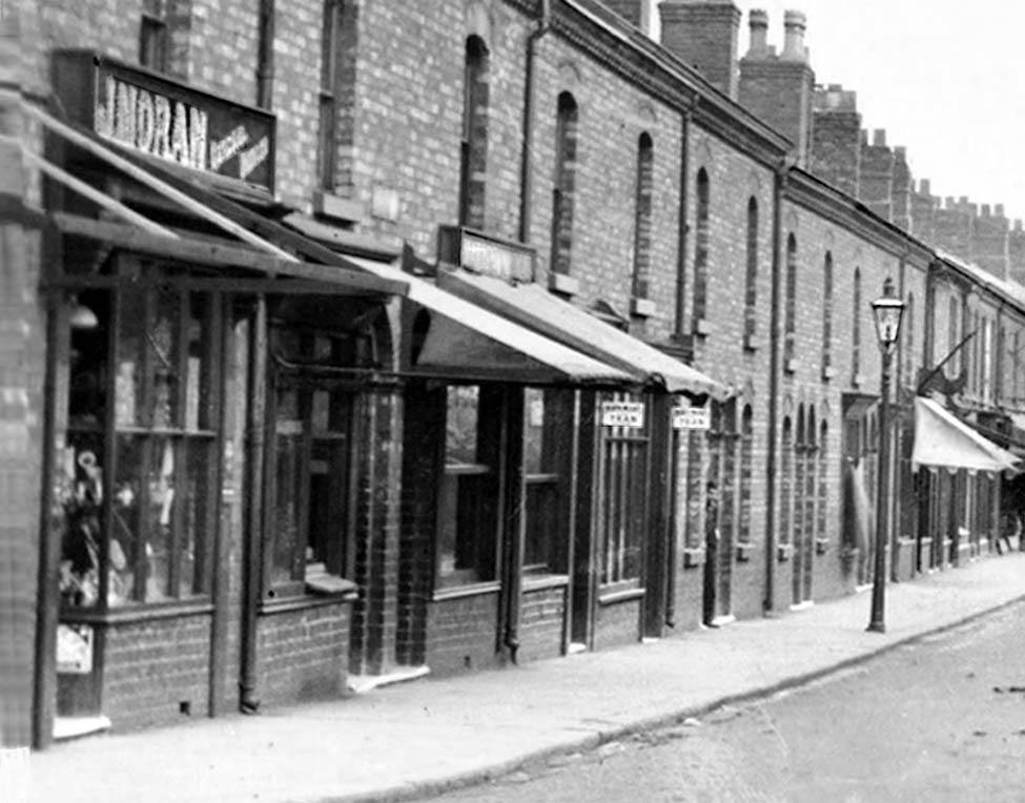
Joseph Moran's wife, Sarah, was a dressmaker at no. 7 Junction Lane with Marsh's greengrocer next door

Joseph Moran's wife was a dressmaker at 7 Junction Lane, Sutton

Junction Lane shops in Sutton c.1910
Amelia Johnson at no. 89 had the relatively new trade of newsagent, as an increasingly literate population were purchasing newspapers such as the Daily Mail, which was first published in 1896 and quite popular with women. On the right of the above photo appears to be horse dung, which would have been a common sight in Junction Lane with traders making deliveries having horse-driven transport.
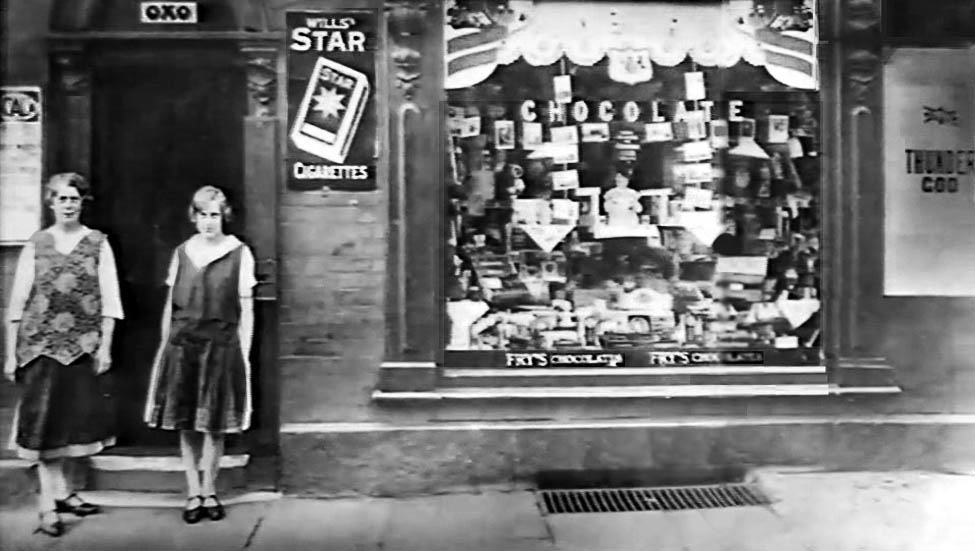
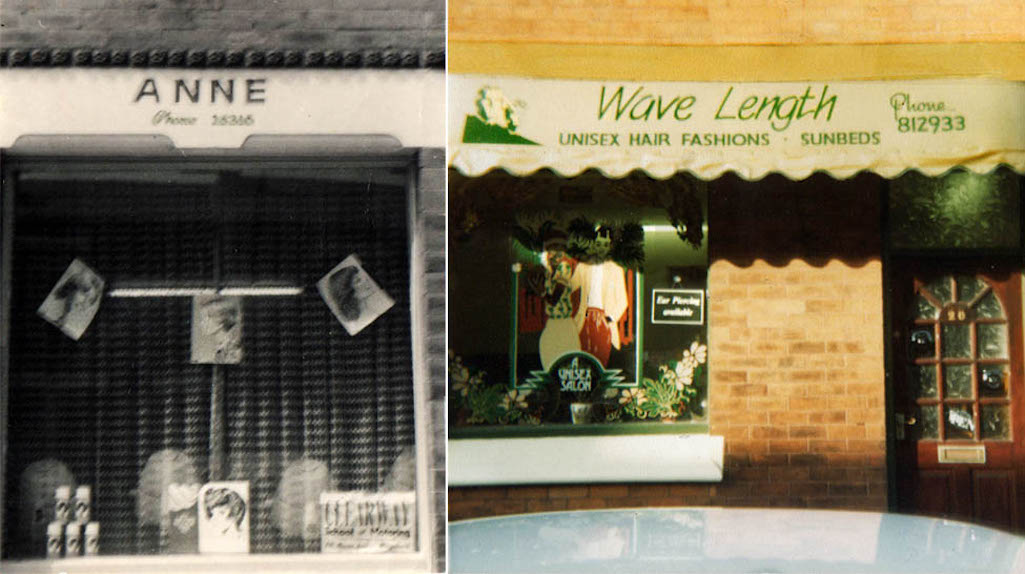
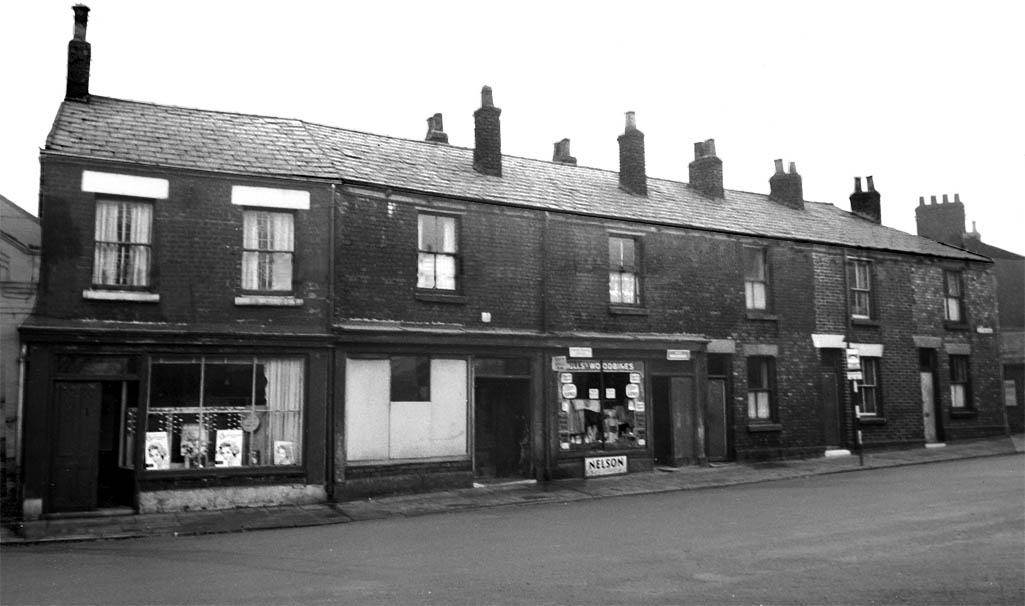
After the war William Rigby kept a butcher’s shop at the bottom end of Junction Lane facing the Junction Inn, and was given the nickname of ‘Billy Beef’.
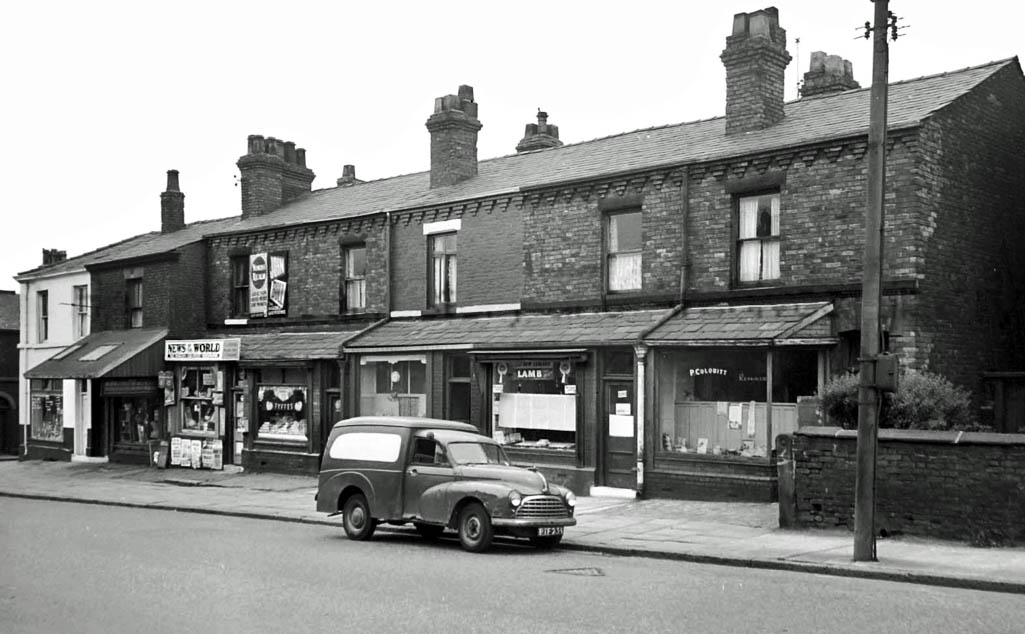
On July 21st 1945 this advert appeared in the Liverpool Echo: ‘WTD. to Buy Country Business (any kind) or Cottage with ground, or would exchange for a good Fish & Chip Business, near St. Helens; genuine offer; child’s health sole reason. – 39 Peckershill Rd., Sutton, St. Helens.’
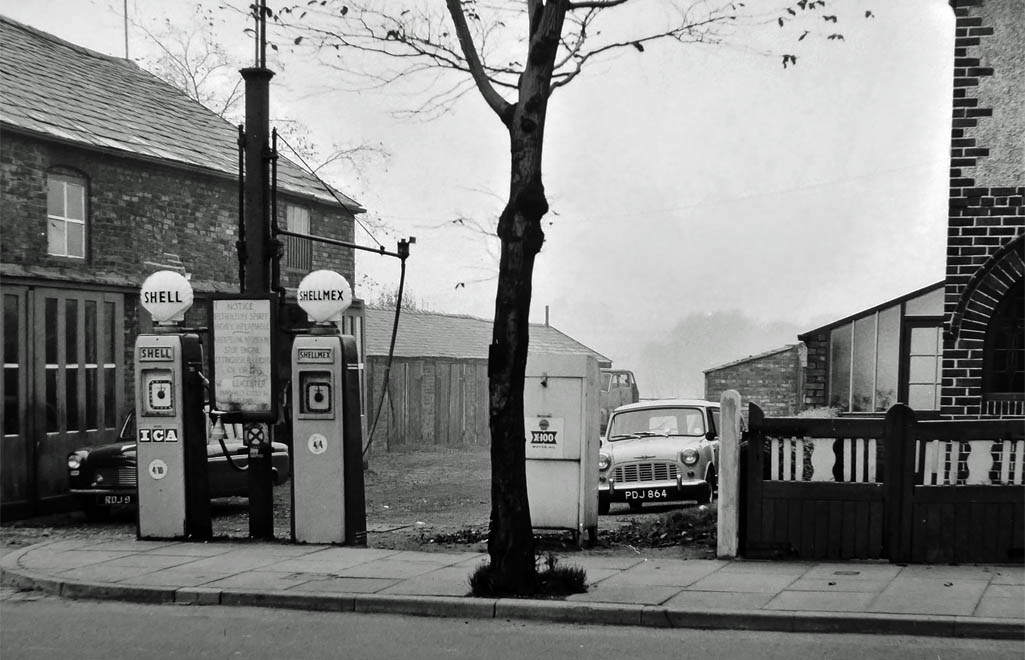
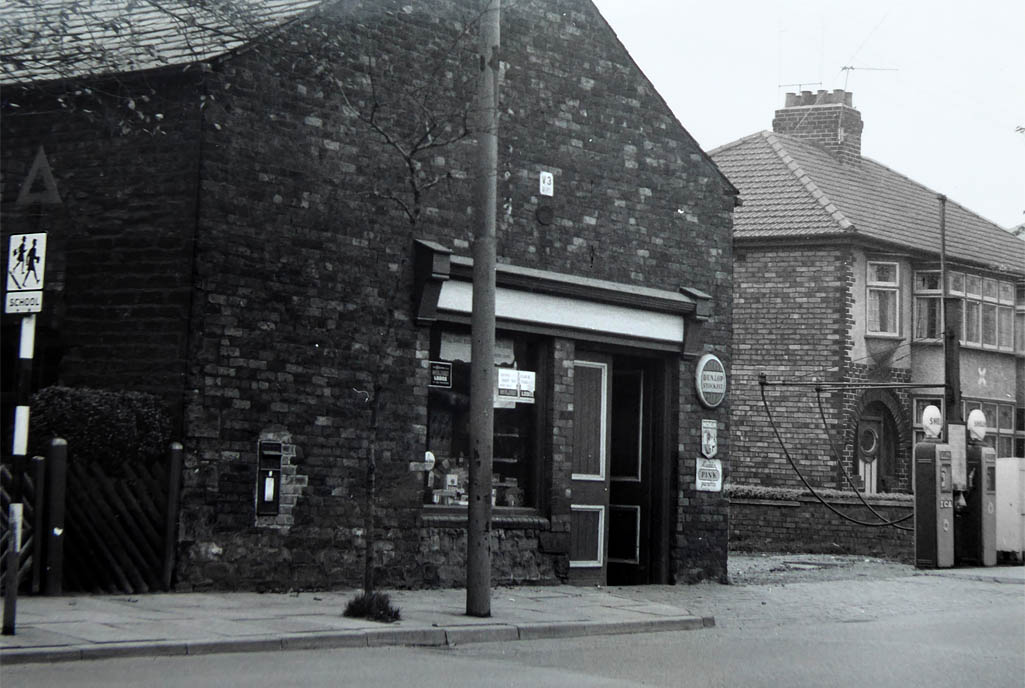
Sutton Shops and Businesses Adverts

Left: St.Helens Newspaper Advert 18th July 1865; Right: St.Helens Lantern 1889 - Walsh was also an East Sutton councillor

St.Helens Newspaper advert from 1865 & St.Helens Lantern from 1889

Left: St.Helens Newspaper from 1865; Right: St.Helens Lantern from 1889

Advertisement for salesman for Royle's pawnbrokers in the Liverpool Mercury of March 9th 1897

Advertisement for Royle's pawnbrokers in the Liverpool Mercury in 1897

Advert in the Liverpool Mercury in 1897
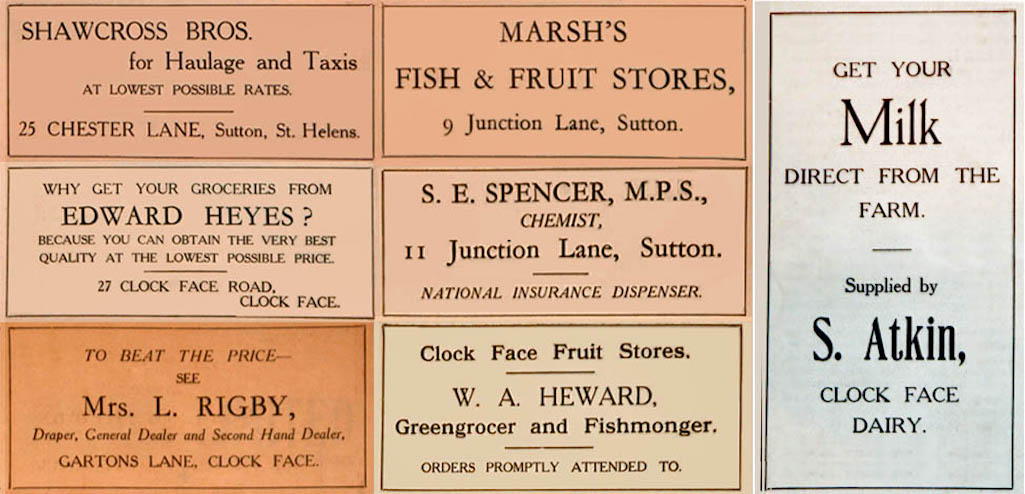

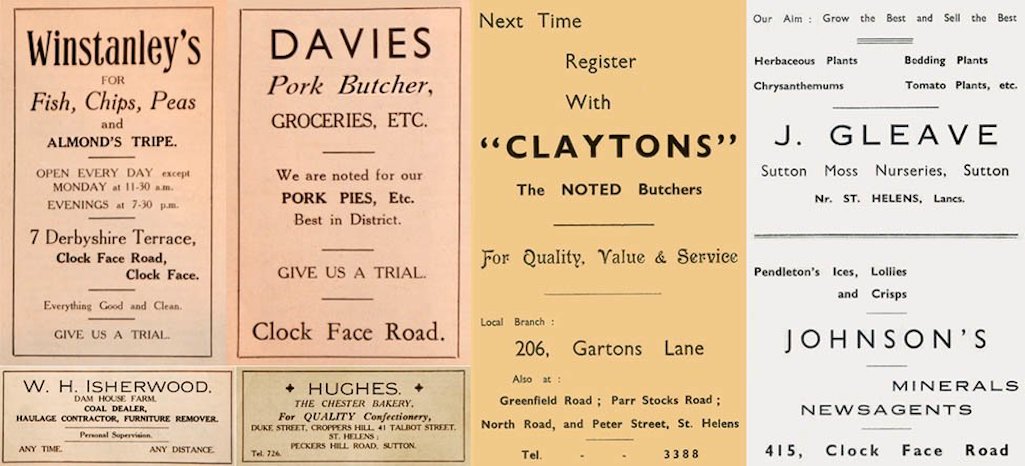
Left: From St.Theresa's 1931 foundation stone laying brochure; Right: Clock Face Colliery Recreation Club 1950 Sports programme

From St.Theresa's 1931 brochure and 1950 Clock Face Sports programme

From 1931 and 1950 brochures

1939 advertisements for Len Davies’s cycle shop and garden contractors W. Byron & Sons of Bold

1939 adverts for Len Davies cycle shop and garden contractors Byron’s

1939 adverts for Len Davies and Byrons
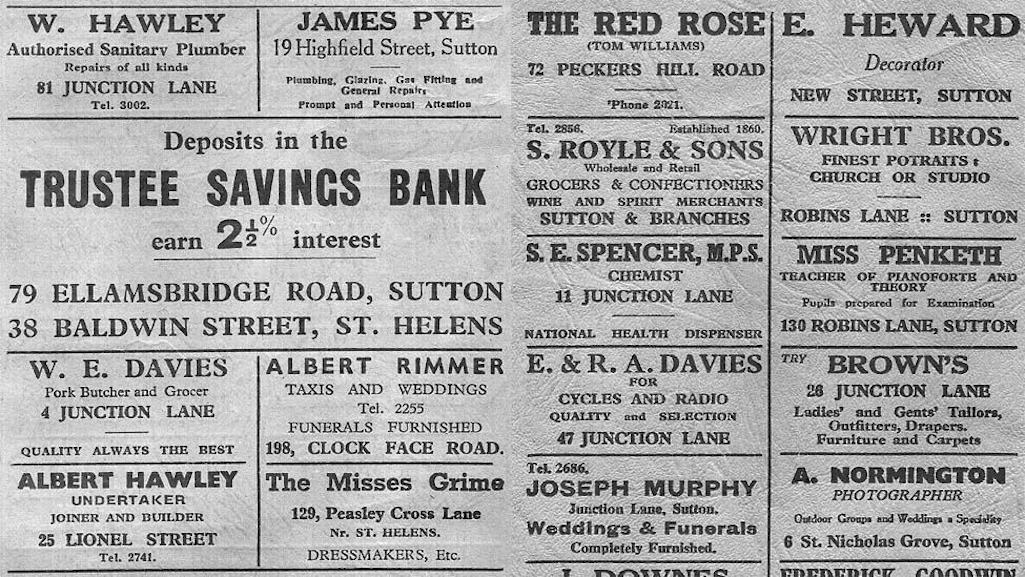
Adverts in the 1949 St.Nicholas centenary church magazine - contributed by James Prescott

Advertisements in the 1949 St.Nicholas centenary church magazine

From 1949 St.Nicholas church magazine
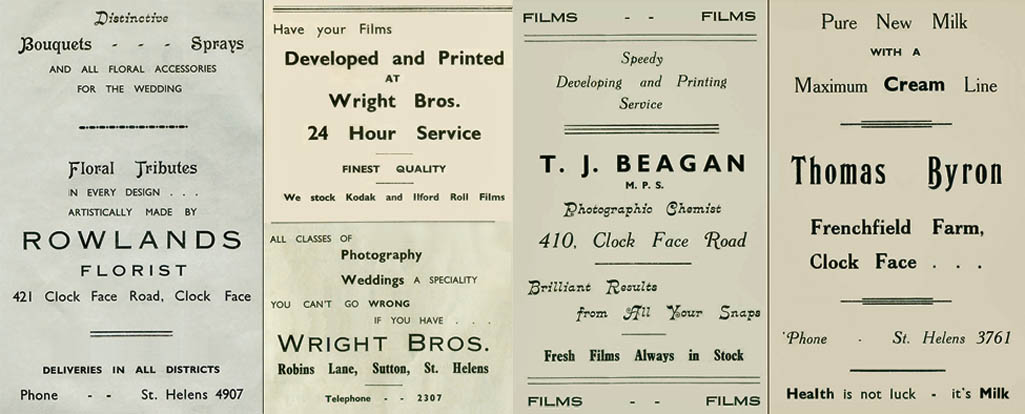
Adverts in the Clock Face Colliery Recreation Club's Athletic Sports programme for 1950

Adverts in the Clock Face Colliery Recreation Club's Sports programme 1950

Adverts in a 1950 sports programme
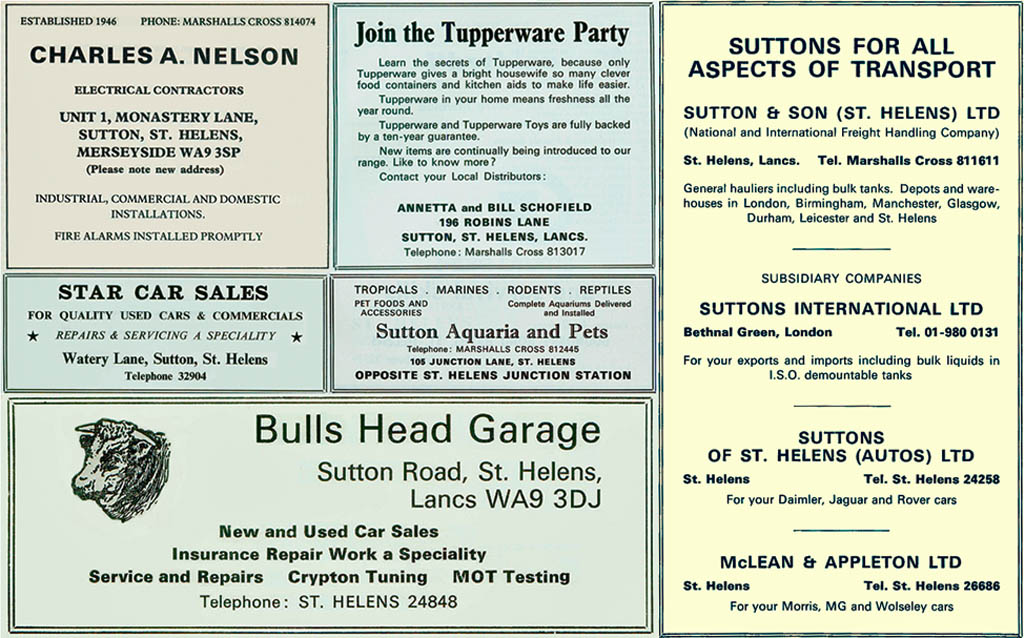
Sutton shop adverts in the St.Helens Official Guide and Industrial Handbook 1973

Sutton shop adverts in the St.Helens Official Guide & Industrial Handbook 1973

Adverts in the St.Helens Guide of 1973
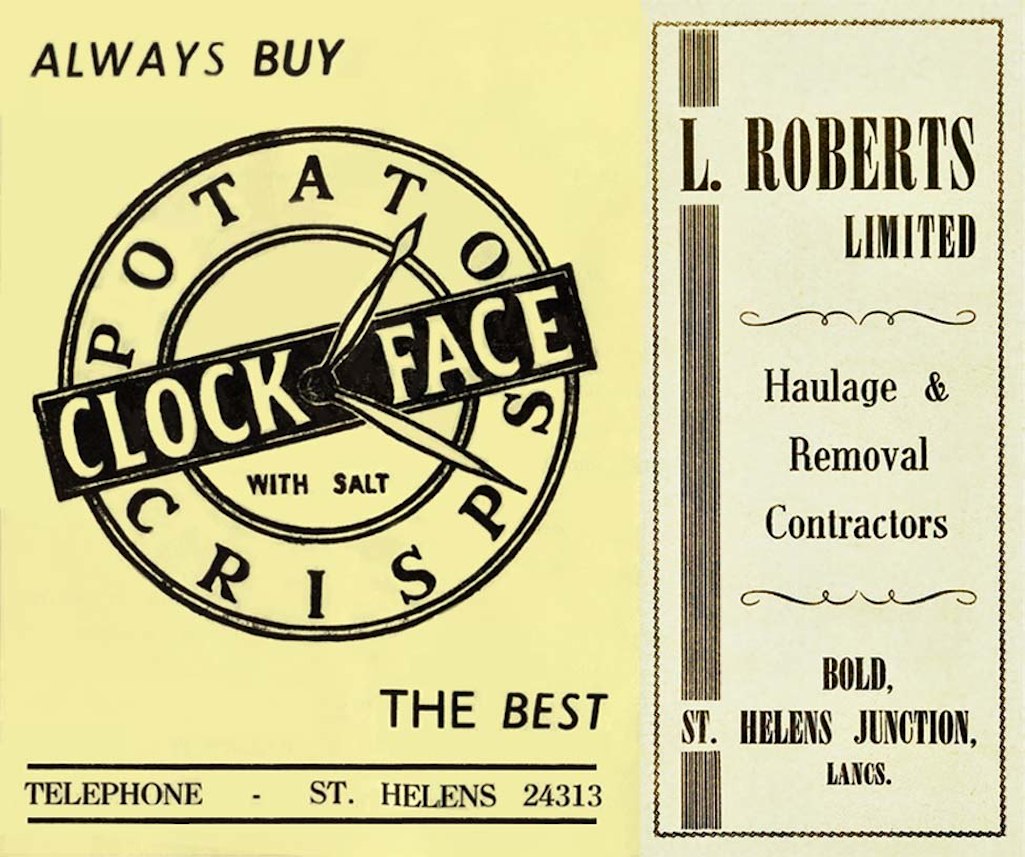
Advert for Clock Face Crisps (date unknown) and an L. Roberts ad which was in a St.Helens street map c.1950

Crisps advert (date unknown) and L. Roberts from St.Helens street map c.1950

Crisps advert date unknown and L. Roberts ad c.1950
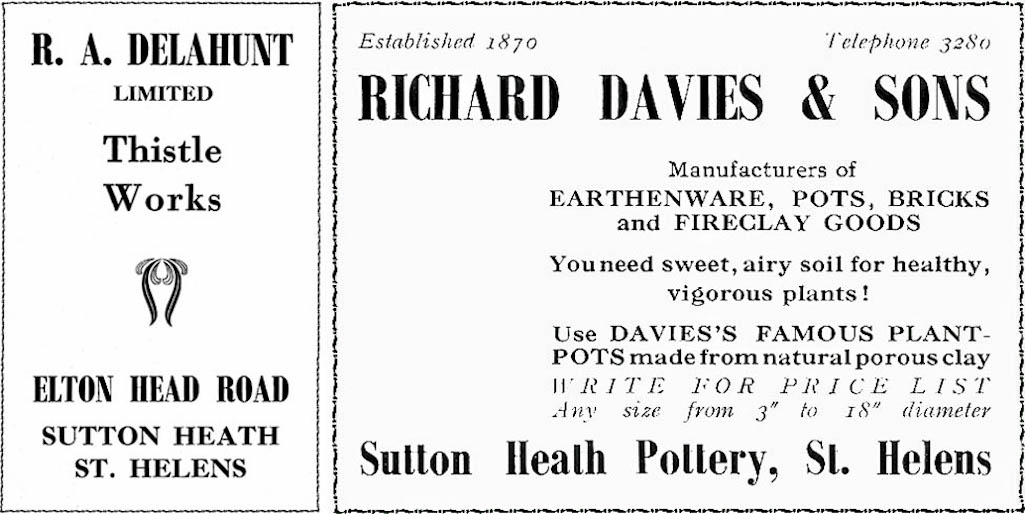
Richard Davies and Delahunt adverts which were in the St.Helens Official Guide c.1951

Richard Davies and Delahunt adverts from St.Helens Official Guide c.1951

From St.Helens Official Guide c.1951
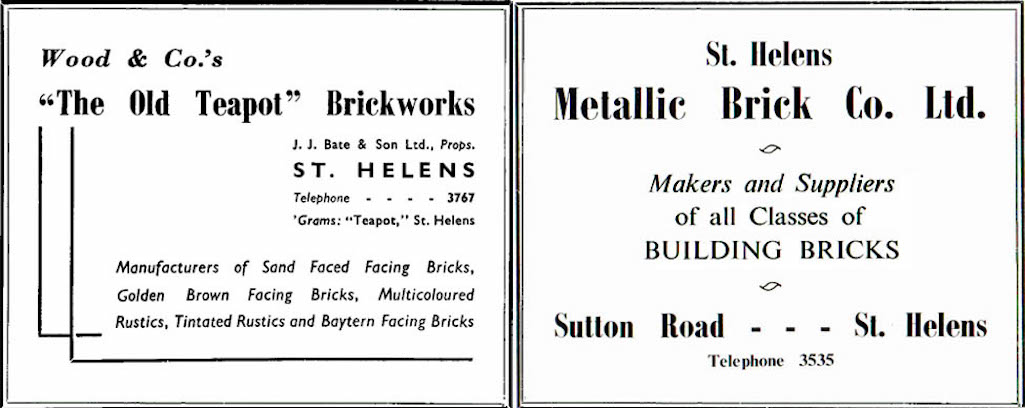
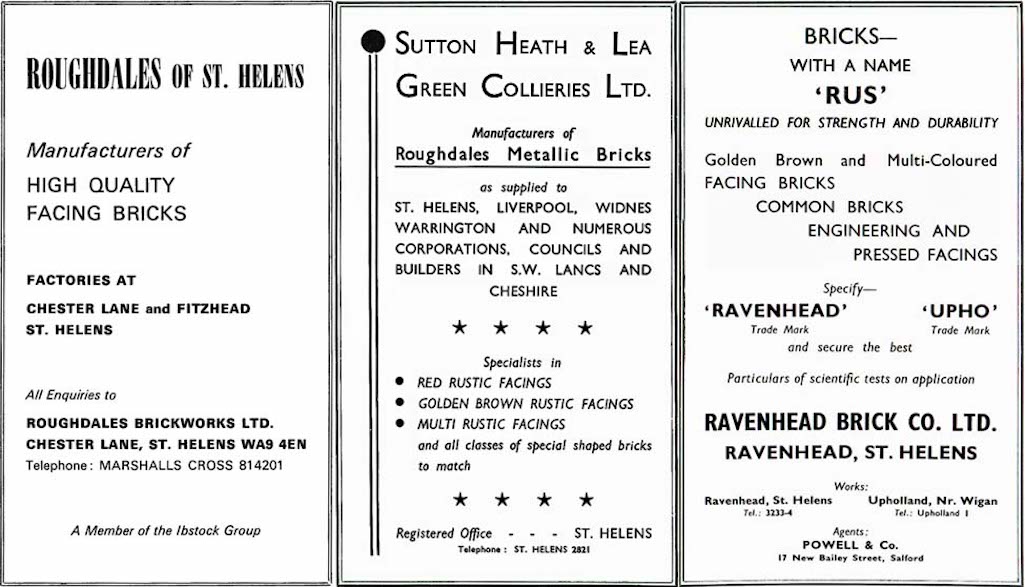
Brickworks adverts from the 1946 Official St.Helens Guide (apart from Roughdales which is from the 1973 version)

Adverts from 1946 St.Helens Guide (except Roughdales from 1973 version)

1946 brickworks adverts - apart from Roughdales ad from 1973
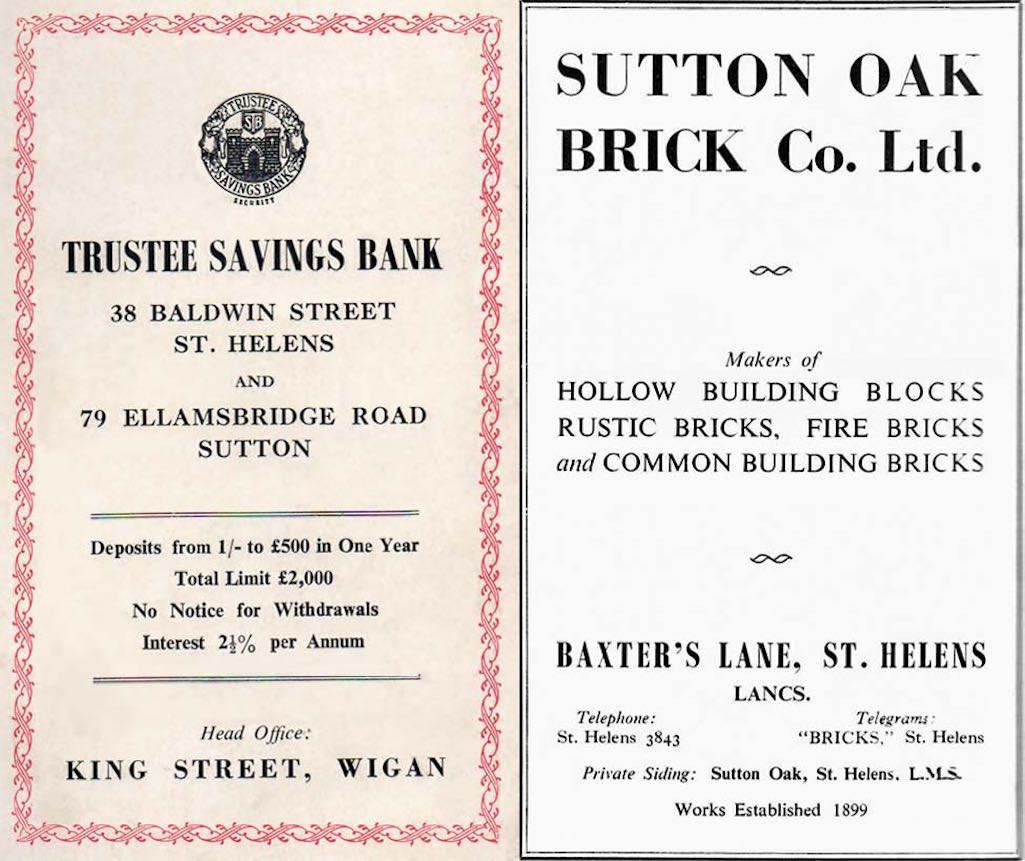
These advertisements were also published in the County Borough of St.Helens Official Guide from 1946

These advertisements were also published in the St.Helens Guide of 1946

From St.Helens Official Guide 1946
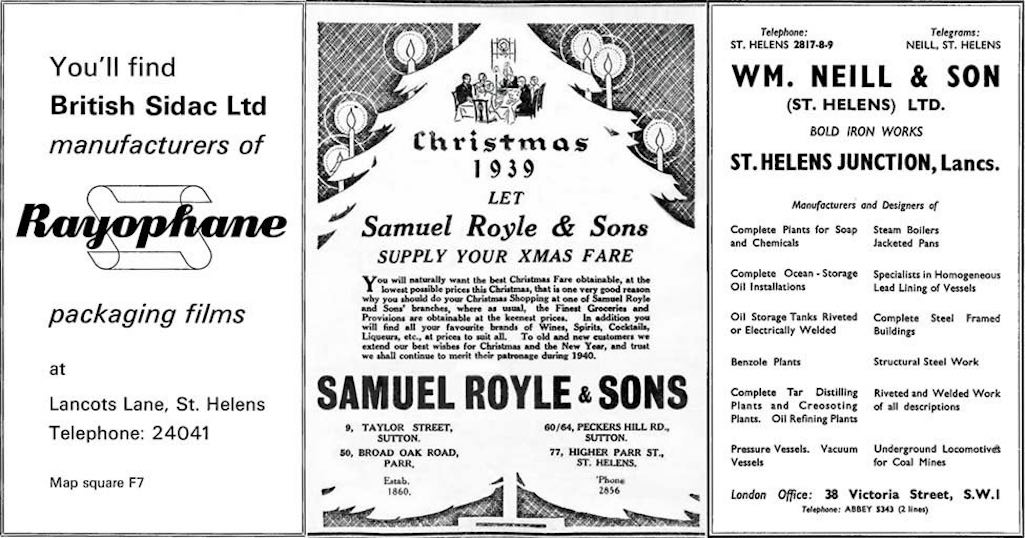
Left: 1973 Official St.Helens Guide; Middle: St.Helens Reporter December 1939; Right: St.Helens Guide 1946

Left: 1973 St.Helens Guide; Middle: St.Helens Reporter; Right: 1946 Guide

Left: 1973; Middle: 1939; Right: 1946


The above adverts are from the St.Helens Official Guide and Industrial Handbook published in 1973

Adverts from the St.Helens Official Guide & Industrial Handbook from 1973

From St.Helens Official Guide 1973
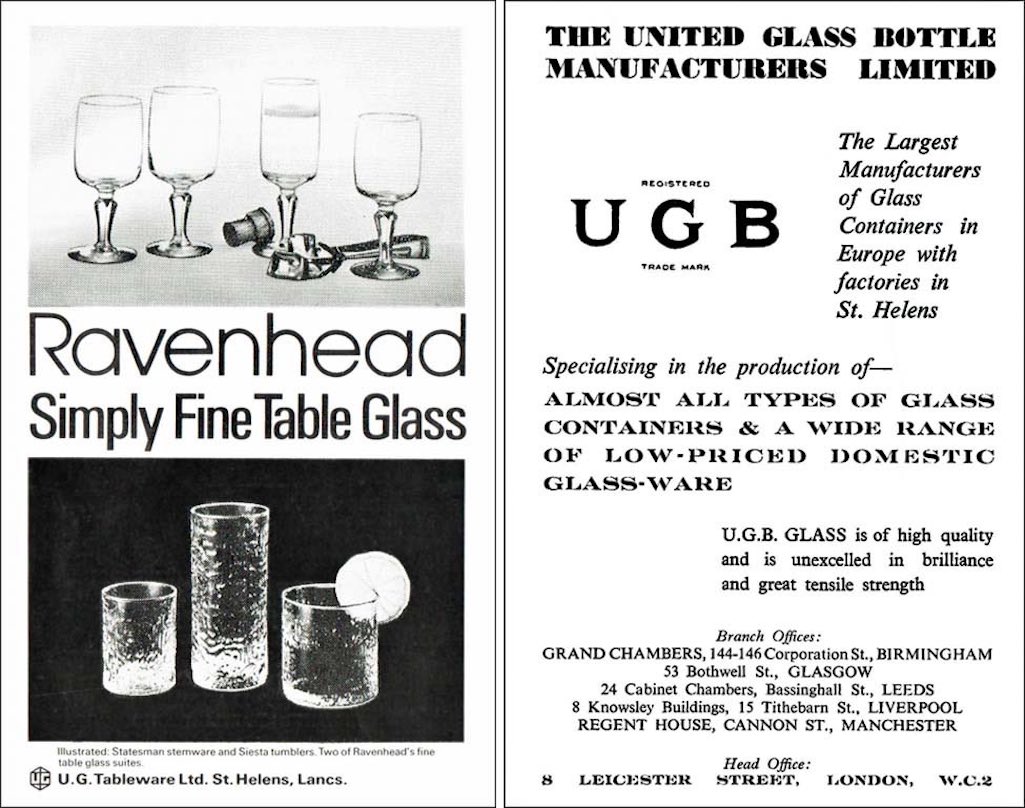
Left: St.Helens Official Guide and Industrial Handbook 1973; Right: Guide published in 1946

Left: St.Helens Official Guide & Industrial Handbook 1973; Right: 1946 Guide

From St.Helens Guides 1973 & 1946

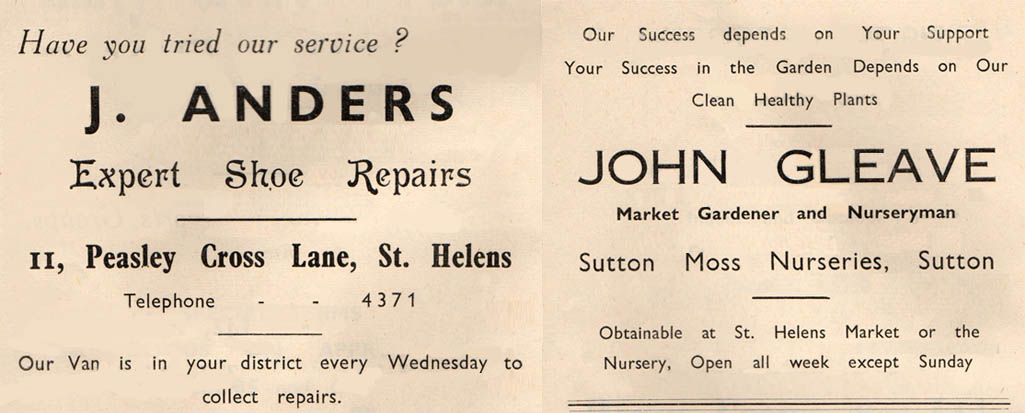
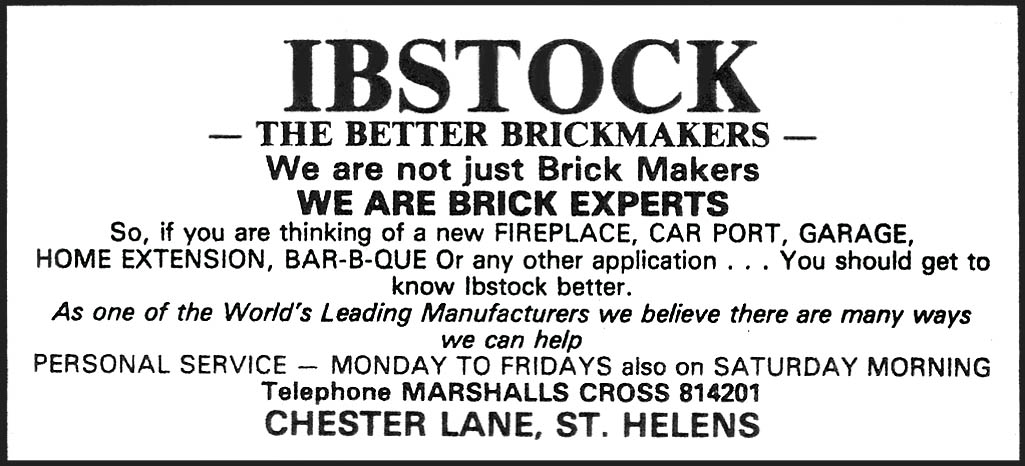
Sutton Shopkeepers and the Effect of Strikes
Strikes were a regular part of industrial life in Sutton as workers organised against harsh conditions and low pay. Although the great hardship endured by striking families is well documented, an often overlooked side-effect of strikes was their impact on shop-keepers. In the days when small shops were the hubs of local communities and with goods often bought on the 'slate' or 'tick' until pay day, it was natural for provisions dealers to allow families whose bread-winner was on strike to have goods on credit.Repayment was promised upon resumption of work and like wars, most strikes began with an expectation of them being short-lived. However many became lengthy and a sizeable debt to shop-keepers could easily accrue. What to do about it was a difficult call for the dealer who often knew the families quite well. The longer the strike lasted and the debts accumulated, the chances of full repayment when back in work receded. With low pay it could take years to clear the arrears and if the shopkeeper stopped their credit, they were probably writing off the debt.
Strikes forced some store-keepers out of business and there were one or two suicides in Sutton. A grocer called Bell was said to have hung himself through the financial consequences of the 1926 lock out and strike. Some chose the legal option and sued their customers in St.Helens County Court and the judges committed a number of debtors to prison. This didn't improve matters as they had no income while locked up. Some people didn't want to pay and strikes were a good excuse for them. Non-payment to shopkeepers was known in Sutton as ‘sloping’. There was even said to have been some houses in one street nicknamed ‘Sloper’s Row’, as the residents were renowned for not paying their debts. In Charles Forman's book 'Industrial Town', the daughter of a Robins Lane shopkeeper said: "Sloping is the word we had for people who had stuff on credit and wouldn’t pay...there'd be a lot of sloping when the colliers were out on strike."
A distinction can be drawn between non-payment by strikers and by those who’d returned to work. On 28th September 1882 the wife of a Sutton miner appeared in St.Helens County Court as a result of the family running up a £27 debt with a provision dealer. That’s more than £1300 in today’s money. The appropriately named Judge Collier commented on how hard it was for shopkeepers who supported miners’ families during strikes but who were afterwards denied payment. Drinking in the local ale-house could serve as the trigger for a writ. Those who undertook tough jobs like mining would understandably feel the need to quench their thirst after work, but it could be quite infuriating for shopkeepers who saw men who owed them money supping away.
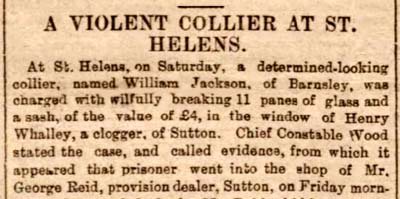
The shop had been run by James Leigh, a leading light in the Sutton Methodist church, until his death at a young age in 1891. His widow Elizabeth then took over the shop, assisted by her younger brother George. She told the miner that if he’d asked more politely, she would have given him something to eat. At this point 50-years-old Henry Whalley entered the shop and told Jackson that he should be ashamed of himself. Henry was a clogmaker with a shop opposite the grocer’s at 25 Worsley Brow. He said he knew that Jackson had been drinking all week but was now demanding free bread.
Jackson argued with Whalley as he crossed the road to his clogging shop but then went away. However he returned at 1:30pm carrying a large stone on his shoulder that was said to weigh 57lb. The miner, who originated from Barnsley, hurled the stone through the clogmaker’s window and then threw a second. George Reid witnessed the vandalism from his own shop and immediately ran across the road. He seized and held Jackson while clogger Whalley fetched PC Henry Fillingham, who took the miner into custody. Next day in St.Helens Police Court, William Jackson was sent to jail for two months for his violent act. However he’d caused £4 worth of damage to Whalley’s shop, which was a lot of money in those days. As most businesses were then uninsured, the clogger probably wished that George Reid had just given the miner the bread. It wasn't easy being a shopkeeper in old Sutton!
Sutton's Post Offices & Postal Service
Although letters have been delivered in Sutton for hundreds of years, the first ‘government’ post office in St Helens was only opened in 1852. Until then Prescot was the local post town with Richard Greenhalgh's wine and spirit merchants in Market Street dealing with the St Helens post as a sideline. The introduction of the Penny Post in 1840 revolutionised the sending of letters and led to the system of pre-paid post, pillar and letter boxes and the main and sub-post office network that we know today.Sutton’s first postman under the new system was William Woodstock who was appointed in 1852. In fact he was the first in St Helens and initially had to deliver 6,000 letters per month by himself on foot. He had a huge patch that included Billinge, Eccleston, Windle and Haydock. Presumably he was allowed to use the train, as mail carriers were not permitted to use bicycles until 1880. Soon additional postmen were needed and by the time of Woodstock’s retirement in January 1891, St Helens employed 18 letter carriers who delivered over 400,000 letters and parcels per month. During his 38 years of walking the streets of St.Helens, William Woodstock never had a day’s sickness. Although he retired through rheumatism, probably caused by delivering the mail in all weathers.
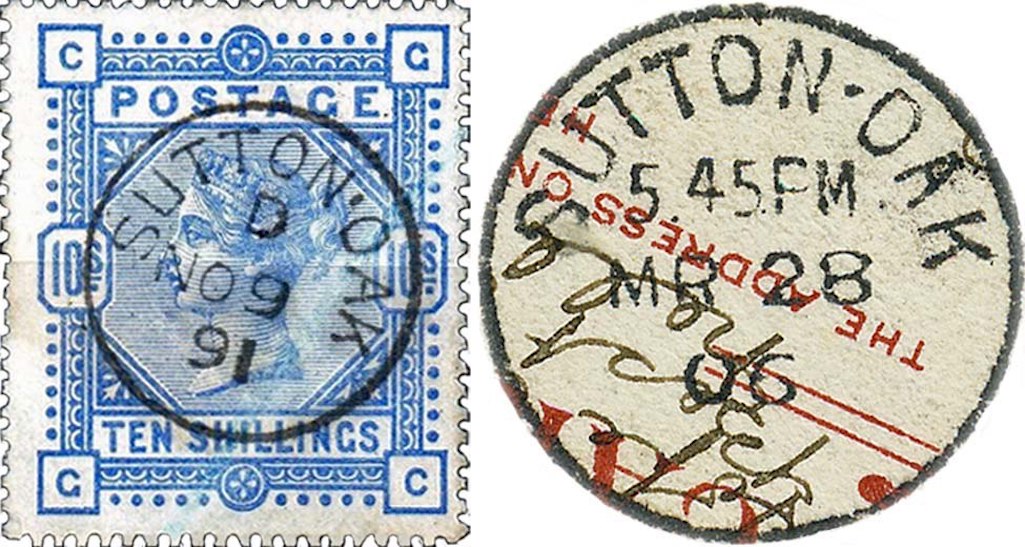
Sutton Oak Post Office franks on a stamp and postcard - the office seems to have also sorted mail from other towns

Sutton Oak Post Office franks on a postage stamp and a postcard

Sutton Oak franks on stamp & postcard
Like today postmen sometimes got in trouble for not always delivering their letters or stealing their contents. On August 9th 1871, 30-years-old letter carrier Thomas Critchley, who was also a watchmaker, was charged at the Liverpool Assizes with stealing. He carried letters between Sutton and St. Helens and after some had gone astray, two test letters were given to Critchley to deliver. They contained marked postage stamps and a quarter rupee silver coin. Critchley exchanged the stamps at the Sutton Post Office and kept the coin for himself. He was sent to prison for five years.
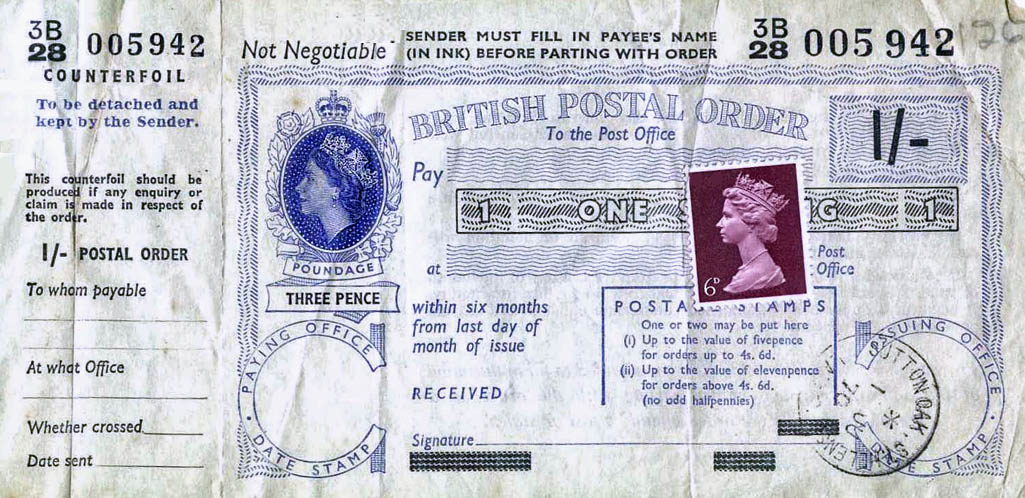
On June 21st 1943 two Mill Lane postmen were sent to prison for pilfering from the post. 48-year-old James Sixsmith was alleged to be the mastermind of a plot to steal postal orders and other items of value, including ration books. He got his friend 49-year-old Thomas Yates, a machine operator also of Mill Lane, to cash and forge postal orders, mainly stolen from football pools. Postman Harry Shaw (48) of 195 Mill Lane, who had lost an eye in the first world war, became involved by stealing food parcels. Sixsmith was sent to prison for 12 months, Yates for 9 months and Shaw was given 3 months.
Memories of Sutton Shops
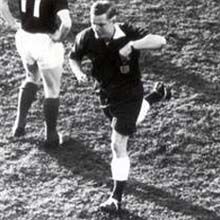
Next came Websters Toffee Shop and then on from number 10 to 30 the families were Scotts, Lathams, then came our house, Granny Whitfield, Mrs Webster (otherwise known as Annie McCann), Birchalls Milk Shop. After the entry came Crosby's (he had a pawn shop in town), McGuiness, Ned Williams, Bulloughs and lastly, Roberts next to St Joseph's Church. On the left hand side from the Griffin was Tickles Flour Mill, Mrs Henderson, Tickles Coffee Shop (ground in the window), Birchalls/Pinders, my grandfather's house, Wiltshires, Brothertons, Connaughtons, Browns/Bevans, Rimmers and one other I can't remember then the Council's Refuse Yard where they kept the horses.
Just further on, on the corner of Appleton Street was Paddy O'Brien's Paper shop. Every New Years Eve, after the locals had been to church, they would congregate around the lamp standard with the priest and the vicar and hold another service. The grandson of Ben Tickle, was Joe Tickle who I believe became a councillor in St Helens and also played rugby for St Helens (Union) although, as a boy, he was born with a club foot, had irons up his leg and I used to push him to school in a pushchair. He moved the business from Sutton Road to Green Lane off MarshaIls Cross Road and died a few years ago in the Lake District where he had retired.
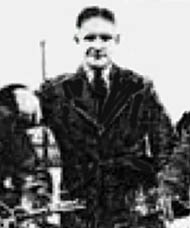
They were mainly small grocery and sweet shops and also took orders for bread. There was one exception to this. It was the shop run by a Miss Price, who opened a small pork butcher’s shop and sold cowheels, trotters and savoury duck. The people running the other small businesses were Mrs. Beasley at No.88, Mrs. McVitie at No.74, Miss Jones at No.58 and Miss Millie Price at No.51.
Mr. John Davies had a large dairy at No.73. This house was the only detached house in the street. It had a fair amount of ground, enclosed by a surrounding wall. It also enclosed stables for four ponies and an enclosure for several milk floats, with the cleansing dairy to the rear of the house. Both Mr. Davies and his wife worked the milk rounds each day, and Mrs. Davies started her round at the front of our house. She summoned the customers by sharp blasts on her whistle and people would come out of their houses with jugs in their hands, and ask for a gill or a pint. Mrs. Davies would then take the lid off the large churn of milk and measure out, by means of a gill or pint scoop, which had a handle attached to it, bent over at the top to rest on the lip of the churn.
On receiving the milk, customers would pay there and then, and Mrs. Davies would give them change, if necessary, out of a leather bag which she had slung at her waist and leather straps over her shoulder. As far as I can remember, the price of milk was 2½ pennies for a pint and one penny and a farthing for a gill of milk. Their son, named Dick, who was a year older than me would go, after coming out of school, to collect the milk from several farms in Bold. I often went with him.
Passing Millie Price's pork shop at No.51, you came, at the end of the row, to Fred Hill's grocery shop. It was the kind of shop in which you could buy anything in the food line and it also had a fine assortment of toffees, or sweets as they are called these days. Fred Hill took good care we youngsters were kept well supplied. There were Kayli Suckers, Atties Mint Balls, sold at twelve a penny, liquorice sticks and lucky bags at one penny, each containing charms etc. I suppose during Fred Hill’s life behind the counter, followed by his son Harold, thousands of Friday night’s pennies were handed over the counter. A penny was a luxury to hundreds of us kids. The shop at No.31 Edgeworth Street has now been pulled down.
When the winter nights closed in on us, several of us youngsters would gather at the front of Hill’s shop window. One of us would be chosen to start off the game of guessing. Our noses would be pressed up to the window, examining every article which was on show. The one chosen to start off the game would give the first and last letters of something that was in the window, e.g. the letters K and I, which would be Kayli. The one who guessed it would be ready to call out the name Kayli and run across the road, touch the opposite side of the street and back again to the shop window. The winner of the two runners had the next chance to call out the first and last letter of the article he chose.
My mother got up at five o'clock in the morning and bought all her wholesale stuff at St John's market in Liverpool. The horses brought the stuff back here – there were a big horse and a little pony. The horse brought the boxes of oranges, and the pony brought the cabbages and that sort of thing. We bought the fish from Mars – they had a wholesale market at the back of the Savoy. It was a big sale and started at seven o'clock.
When it was Ash Wednesday and Good Friday, we were very busy – we used to say they were our harvest – we'd come back with nothing left in the cart. We used to sell a few rabbits too, what they called frozen rabbits – they were cheaper. We hung the rabbits on rods and thawed them either side of the stove. This stove was old fashioned with a hole at the top, and you used to put a fire underneath. I used to skin the rabbits, hundreds of them. We used to get 2d each for the rabbit skins, and that was our profit. I took them in the cart on Thursdays to the rag-and-bone place that they turned into the Co-op.
We had a good round with our two carts in those days. You went to people, not them coming to you. Even Charlie King, who just sold bananas, did a round – he was known as the Banana King. My brothers stayed half days from school working for my mother. When they left school they wanted to go out to work, and they were all taken on at Bold Colliery. Their wages were more than my mother's. We had to sell both horses when the lads started working – there was no one to do the rounds. They kept leaving school – there was only two years between each one of them and they'd soon all left. I had three sisters and one of them did a round in the cart at Burtonwood. She got married from the shop – we all did.
Our business went flop because the Co-op opened on Robins Lane. They used to slope us and they'd take their money to the stores. They got three shillings back in the pound there. Sloping is the word we had for people who had stuff on credit and wouldn't pay. There was my mother getting up at all hours and getting nothing for it. Most people round us were colliers and railwaymen, and there'd be a lot of sloping when the colliers were out on strike.
My mother didn't pay me – we were lucky to get our keep in those days. But she always had us well dressed. When I married my husband she said: “You pay his board and I'll keep you for nothing”. If I wanted to go anywhere special I had to ask my father. My father was very strict. I wouldn't dare give him back again. If I had my life over again, I would have gone out to work, too, like my brothers did. I worked jolly hard and I got nothing for it. Most of the people didn't who worked for their own family.



